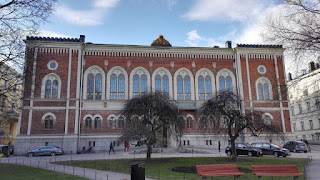Näin Harry
Kupferiin ohjaaman Parsifalin jo vuonna 2005, kun se oli ensi-illassa
Kansallisoopperassa, mutta pakko myöntää, että mielikuvani siitä olivat jo
reippaasti hämärtyneet. Siksi päätinkin käydä katsomassa sen nyt uudemman
kerran, kun se nyt palasi oopperan ohjelmistoon. Esityksen lavastusta (Hans
Schavernoch) ja valaistusta (Andrew Voller) on uusinta-arvioissa arvosteltu
vanhanaikaisiksi, mutta on hyvä muistaa, että kaikki ei ole iätöntä ja
kymmenessä vuodessa uusimmasta hotista voi helposti tulla tavanomaista. Eivät
lavastus ja valaistus mitään vau-efektiä enää saaneet aikaan, mutta eivät ne
mitenkään huonojakaan olleet.
Parsifalin
juoni on pala jatkumoa, mutta lyhyesti kerrottuna, se on tarina viattomasta
Parsifalista, joka kiusausta vastustamalla onnistuu vapauttamaan haavoittuneen
Amfortaksen tuskistaan ja pelastamaan Graalin ritarikunnan tuholta.
Totta puhuen
en erityisemmin välittänyt teoksen ohjauksesta. Oopperassa oli ihan liikaa lattialla
makaamista ja ryömimistä. Kai niiden oli tarkoitus vahvoja tunteita ilmaista,
mutta ainakaan minun kohdallani ne eivät toimineet. Onneksi Wagnerin musiikki
on niin hienoa, että siihen keskittymällä tylsempikin ohjaus menettelee.
Ja Wagneriin
olikin hyvä keskittyä, sillä kapellimestari Pinchas Steinberg sai
Kansallisoopperan orkesterin soimaan todella iskevästi. Ja kun solistikuntakin
hoiti tehtävänsä kiitettävästi, niin mikäs siinä oli viisi tuntia istua
Wagneria kuuntelemassa. Eniten pidin Tommi Hakalan Amfortaksesta; hän sai
tuskan ja itsesyytökset oikeasti kuulumaan äänessään. Myös Tuija Knihtilä
Kundrynä lauloi hienosti, vaikka Kundry oli tässä ohjauksessa mielestäni
turhankin kliseinen rooli. Parsifalin roolin laulanut Nikolai Schukoff teki
myös hyvää työtä, joskin ei hän viime kesän Turun esityksen Klaus Florian
Vogtin tasolle yltänyt. Gurnemanzin roolin lauloi Jyrki Korhonen: ääni toimi
loistavasti, mutta olin hieman pettynyt hänen esitykseensä. Jyrki Korhonen on
parhaillaan niin hieno esiintyjä, että odotin nytkin häneltä enemmän, mutta
olihan tämä toki hänen ensimmäinen Gurnemanzinsa.













